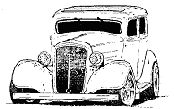Fifteen Minutes with Artist Keith Weesner
It wouldn't be accurate to call Keith Weesner an automotive artist. He's an artist. Sure, you can see his work in hot rodding magazines and on the chests of any fan who has purchased one of his T-shirts at a hot rod get-together--but you can also see it hanging on the walls of fancy galleries, where patrons of the arts, who may have never been to a rod run, happily shell out serious money for an original Keith Weesner painting. He's a member of the Burbank Choppers, a car club dedicated to building, driving, and promoting traditionally-accurate rods and customs. He's doing a great job of exposing hot rodders to fine art, and exposing the rest of the world to hot rodding. We cornered Keith at a recent outdoor car show and barraged him with some of the questions we'd been saving just for the occasion.
R&C: Who were artists that influenced you to become an artist?
KW: There are many painters and illustrators I like, and it's different for different categories. I always liked N.C. Wyeth for all his
illustrations. I loved how chunky and real his stuff was, but yet very accurate and very lifelike. As far as car art, I was influenced by all the artists I saw in Hot Rod Magazine through the late '70s and early '80s, such as Thom Taylor and Steve Stanford.
R&C: Is that was motivated you to go to art school?
KW: What finally got me to go to school was seeing Harry Bradley's layouts, mostly in Street Rodder, I think. His car designs would continue for four pages with a cross section of the fender and the headlight. I remember seeing an original illustration about 20 years ago, and I knew that he was an instructor at Art Center in Pasadena, so I decided that I had to go to Art Center. I was at Art Center in the late '80s, and was on the car designer track. Right about the same time, I first started making friends with people who were involved in the fledgling low-brow art scene in Los Angeles, and got to know a lot of the key players. That influence was rubbing off on me while I was learning how to paint.
R&C: Is that what moved you toward painting?
KW: I was doing a lot of the marker and chalk type of art and illustration that you learn how to do at Art Center, but I felt a little limited by that. Steve Stanford has taken that style to a level that no one can come close to. I wanted my work to look more like fine art painting. I just started messing around with that more and more. It took me a long time to strike a balance between something that looked like an Edward Hopper painting and something that was an accurate depiction of a car. I wanted the excitement and the accurate look of chrome and paint that a design sketch would have, but I also wanted it to have the warmth of a painting. It took me a while to get where I could have both of those elements.
R&C: Are you surprised to see hot rodders and custom car guys in galleries looking at your art?
KW: We're into the same thing. I'm building cars, and driving them, and drawing them. I'm always thinking about images of different places, and the cars and people that are there. The kind of world I imagined and drew pictures of back in the '80s has all come to life. I used to wonder, what if there was a car club building old time cars, and they were all kind of edgy-looking hooligans? That's all real now.
R&C: Why do you think people are so fascinated by that?
KW: When you pick up an old car magazine from the '50s or a book with pictures from the dry lakes, there's just something about it that tugs at you. There's also a certain level of dissatisfaction with modern life and the culture surrounding modern life. Sometimes I feel as if I'm at war with the modern world--like when I'm driving my '60s car trying not to get run over by SUVs everyday. Maybe we should buy a new car, I don't know. We've never had one. I have to drive an old car. I can't help myself, that's just what we do.It's really exciting that all of this is going on. I think people need to dig deeper into what they're doing. Don't build a car just like Joe's because that's how Joe built it. Copying somebody else is not going to get you very far. That's true with cars and it's true with art. Somebody might look at my art and want to copy it. But I'm not copying somebody else; I'm going to museums and looking at the whole history of art. Things that are good have a broad spectrum of influences narrowed down into that thing. Cars would be better if people understood the history, and knew what it means and what's behind it. |



 Keith Weesner
Keith Weesner



 Keith Weesner
Keith Weesner